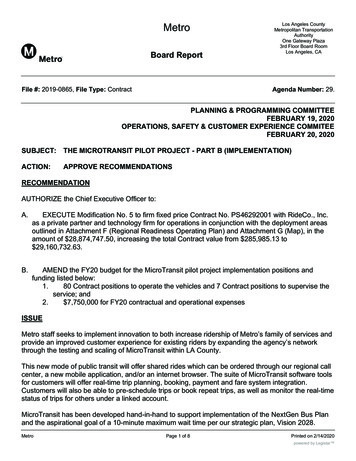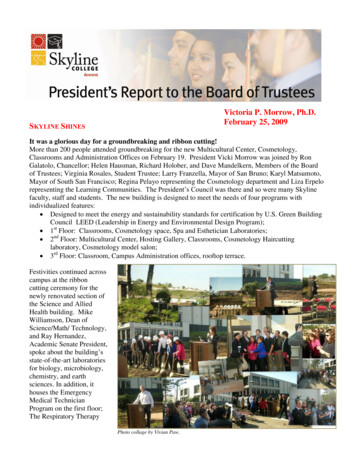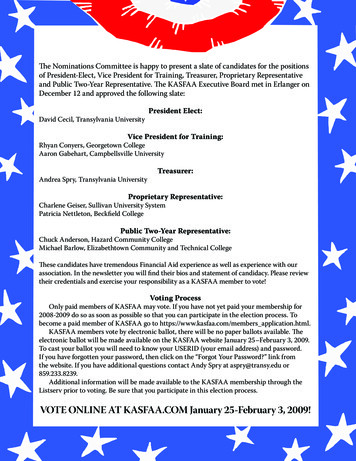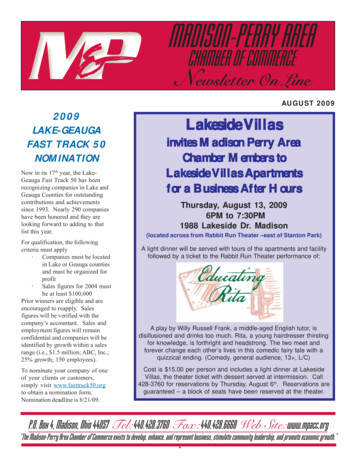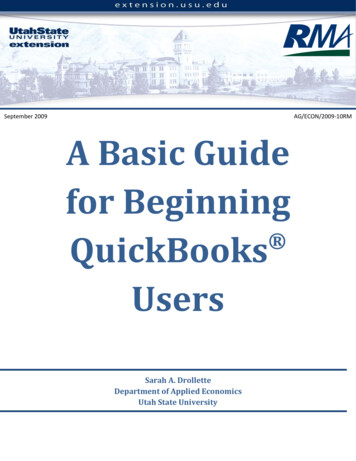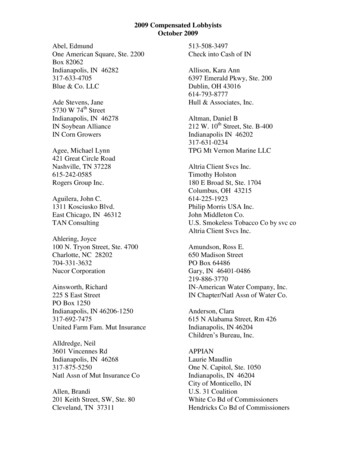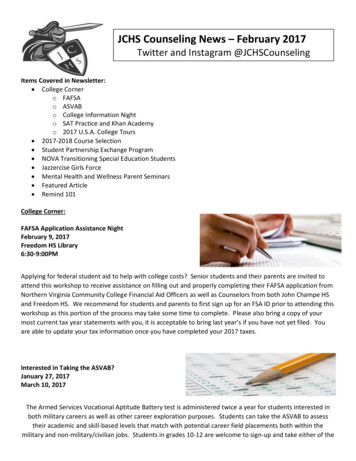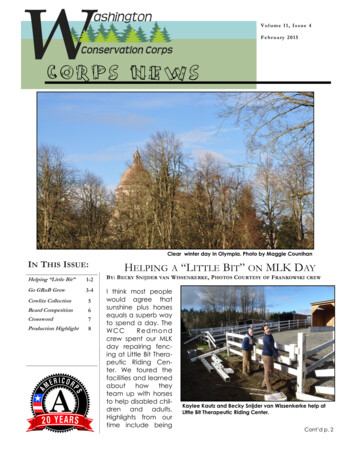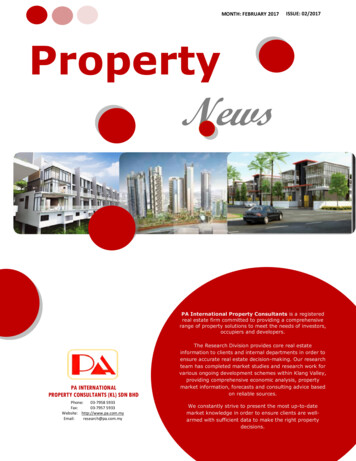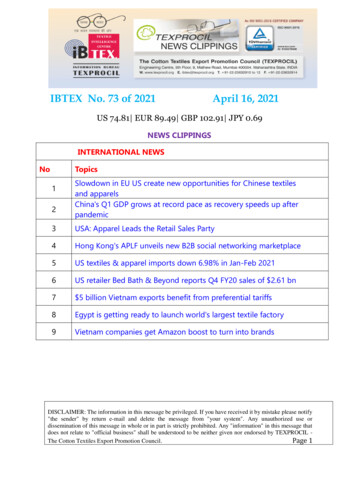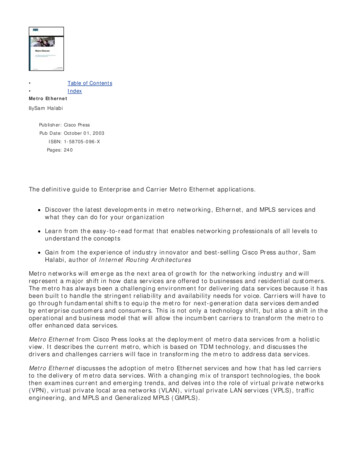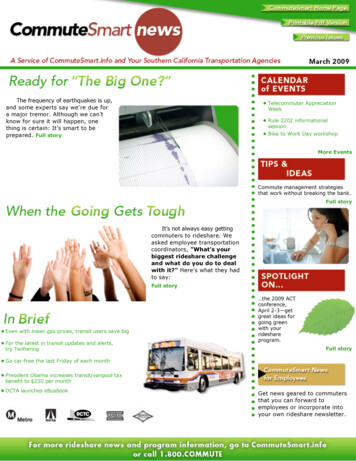
Transcription
The frequency of earthquakes is up,and some experts say we're due fora major tremor. Although we can’tknow for sure it will happen, onething is certain: It’s smart to beprepared. Full story Telecommuter AppreciationWeek Rule 2202 informationalsession Bike to Work Day workshopMore EventsCommute management strategiesthat work without breaking the bank.Full storyIt’s not always easy gettingcommuters to rideshare. Weasked employee transportationcoordinators, "What’s yourbiggest rideshare challengeand what do you do to dealwith it?" Here’s what they hadto say:Full story Even with lower gas prices, transit users save big For the latest in transit updates and alerts,try Twittering the 2009 ACTconference,April 2-3—getgreat ideas forgoing greenwith yourrideshareprogram.Full story Go car-free the last Friday of each month President Obama increases transit/vanpool taxbenefit to 230 per month OCTA launches eBusbookGet news geared to commutersthat you can forward toemployees or incorporate intoyour own rideshare newsletter.
Southern California last year experienced the highest number of earthquakes since1999, according to data from Caltech and the US Geological Survey. There were 267quakes of at least a magnitude 3.0 in 2008—more than twice that of the year before.If that’s not enough, a new study by UC Irvine warned that, based on patterns ofquake frequency, we might soon be due for "the big one." Although we can’t know forsure it will happen, one thing is certain: It’s smart to be prepared."Downed freeways and blocked roads can stymie commutes," says Brian Cunananwith Riverside County Transportation Commission. "Putting a few strategies in placenow can help your employees cope with the days and weeks after a quake."Here, the experts at CommuteSmart.info offer some tips for establishing a crisiscommuting program:What You Can Do Now: Distribute RideGuides as a back-up plan. When you hand out RideGuides toemployees (which they get free when they complete their annual transportationsurvey), suggest they keep them on hand for an emergency—even if they’re notcurrently interested in ridesharing.Keep a print-out with employee commute data, including home cities, howthey currently commute and contact information. If Internet service is disruptedand you need to match employees, you'll have what you need to do it the "oldfashioned way."Train employees now for crisis telecommuting. Set the rules for working offsite—even if it is an option only available as a backup. Employees will need toknow how to set up an at-home work station, how to effectively communicatewith the home office, and methods for tracking performance while off site.Once a Crisis Occurs: Implement an emergency schedule to keep commuters off the road during peak periods.Stagger arrival or departure times, or schedule to work longer hours fewer days per week. Sell transit passes at your work site, or provide phone numbers for transit organizations. Enact a temporary business travel policy: Conduct conferences by phone instead of in person Restrict sales and service calls to non-peak hours Redefine sales territories close to employees’ homes Allow employees to work at home or at satellite work offices near theirhomes (often employees themselves can suggest a location with properfacilities).Stock a kiosk with transit and express bus schedules, rail information,route recommendations, etc.Meet with companies in your neighborhood to create an emergency plan.Share parking facilities, shuttle costs and workspace. Use your meeting time toplan ahead—and don’t forget to collect home phone numbers in the event thatcoordinators cannot be reached at their offices.Provide ridematching help by urging employees to go to CommuteSmart.info or call 1.800.COMMUTE.
It’s not always easy getting commuters to rideshare. We asked employee transportation coordinators,"What’s your biggest rideshare challenge and what do you do to deal with it?" Here’s what they had to say:Trish Casella, Advanced BionicsSonia Reading, Verdugo Hills HospitalPaula Stewart, Daily News of Los AngelesCHALLENGE: Finding time to explain therideshare program to each employee whorequests itCHALLENGE: Employees not alwaysreading the rideshare flyersCHALLENGE: Finding the time to deal withrideshare paperworkSOLUTION: Reach employees through avariety of ways—Internet, flyers, mailers,pay check stuffers, bulletin boards andquarterly announcements—to increase thechances at least one will get noticedSOLUTION: Convert manualrecordkeeping to electronic and makeemployees more responsible for filling outtheir own paperwork to earn ridesharebenefitsColette Romero, Co-opportunityGeorge Gray, TeradyneCHALLENGE: Competition for employees’attention makes it hard to get the ridesharemessage noticedCHALLENGE: Helping employeesunderstand the rideshare programSOLUTION: Prepare a Powerpointpresentation that explains program benefitsLillian Huerta, Angelus Sanitary CanMachine Co.CHALLENGE: Rideshare budget goestoward monthly raffle so none is left formarketingSOLUTION: Post pictures of raffle winnerson bulletin boards and monitors throughoutthe company for no-cost publicityDevon Deming, Los Angeles World AirportsSOLUTION: Position the ballot box for theirrideshare drawing—as well as posters andprogram updates—on the break room doorwhere people are sure to see itCHALLENGE: Getting management tounderstand what the rideshare departmentdoes and how it fits in the bigger picture ofrunning a successful businessSOLUTION: Get employees thatparticipate in the plan to explain thebenefits to potential participantsRocio Nakandakari, RiconCHALLENGE: Find enough employees toform a vanpoolSOLUTION: Coordinate with other ETCs toform vanpools among neighboringcompaniesSOLUTION: Helping out in times ofchallenge—i.e., when the company neededto relocate employees from the Ontarioairport to LAX, the rideshare departmentdeployed two vanpools to ease thetransitionBonnie J. Oakleaf, Automobile Club ofSouthern CaliforniaCHALLENGE: Getting discouraged whenpeople won’t rideshareKaren White, Memorial Hospital of GardenaPenny Menton, UCLA TransportationServicesCHALLENGE: Finding the right incentive toencourage employees to participateCHALLENGE: Negative attitudes and the "Ican't mentality"SOLUTION: During an "employee sign-upday," they ask employees for suggestionson what incentives they want and award 5gift cards per suggestionSOLUTION: To deal with it, Menton says:“I take a deep breath, dig in my heels andbecome very determined to change theirminds. I also never give up until I at leastget them to try an alternative mode on atrial basis."Trisha Akaba, VerizonMary Williams, The Art Institute ofCaliforniaBetina Cervantes, Cal StateLos AngelesCHALLENGE: Convincing employees whohave to drop off and pick up children atdaycare along that they can still carpoolCHALLENGE: Coming upwith new ideasSOLUTION: Match them with other parentswho may have a similar schedule and whowant to leave the air cleaner for all kidsSOLUTION: Accept that some people willnever rideshare, and focus on those whodo rideshare or may try itCHALLENGE: Unscheduled overtime, whichis a daily occurrenceSOLUTION: Guarantee that carpoolers willget off work on timeSOLUTION: Attend trainingsto learn and get ideas fromother ETCs
Even with lower gas prices, transit users save bigEven though the price of gas is nowhere near what it was last summer,people who ride transit still save on average 8,368 per year based on today’sgas prices, according to an American Public Transportation Association report.It also showed that riding transit could save the average household almost athird more than their entire food bill for a year. For details, go to apta.com For the latest in transit updates and alerts,try TwitteringYour employees who use transit can get important updates and alerts (e.g.,rail and bus schedule changes, amended service, special discounts, etc.) onTwitter—and now Metro is Twittering in Spanish as well as English. Twitter (attwitter.com) is the free service that lets subscribers exchange brief messages,called tweets, to users who receive message updates on their phones via IM,RSS or on the web. Instructions on how to sign up for Twitter messages areavailable for Metro at metro.net and Metrolink at metrolinktrains.com Go car-free the last Friday of each monthThe Los Angeles County Bicycle Coalition is asking commuters to go car-free on thelast Friday of each month. The "Car-Free Friday" campaign launched in January with abike ride from the Western Avenue Metro Red Line station to downtown Los Angeles,and Los Angeles City Council President Eric Garcetti joined riders to show his support.For more information, as well as updates on planned group rides, go to la-bike.org President Obama increases transit/vanpool taxbenefit to 230 per monthThe Emergency Economic Recovery Act signed into law recently byPresident Obama includes a provision that will increase the transit andvanpool tax benefit to 230 per month—up from 120 per month and nowthe same value as the parking benefit. This is effective now and will stayin effect until the end of 2010. OCTA launches eBusbookNow riders can "go green" by building their own free, personalizedeBusbook, which gives them customized route information simply byselecting routes and other services from a list of categories—all easyand online. Check it out at octa.net/ebusbook
The Association forCommuter Transportationregional conference is goingHollywood, but forget the redcarpet. This year, it’s all aboutthe green. The theme is"Keeping the Green Spotlighton Commute Programs" andwhen you attend, you’ll gettips on how to tap into thegreen movement—everythingfrom marketing and legislationto incentives, program ideas,help with meeting mandatesand more.Plus, you’ll discover plenty ofways to save some green andmake the most of yourrideshare efforts no matter what your budget.Here, we talk to ACT Chair Devon Deming, for a "sneak preview" on what'sin store at the conference:Why the green theme?"Now more than ever, the environment is a selling point to get employeesto rideshare. People want to use less gas. They want to do something tostop global warming. The question is, how do we help them make theconnection between that and ridesharing? It may seem obvious to those ofus who work in TDM, but commuters need a nudge. At the conference, that’sone of the things we’re going to explore.how we get employees andmanagement to understand ridesharing’s role in the clean air movement."Who attends?"It really varies, which I think is one of the most valuable aspects of theconference. You’ll have a seasoned pro sitting right next to an ETC whoperhaps just completed her certificate—there’s an amazing opportunity forexchange of information and ideas at every level. Last year’s attendees saidthey felt so energized after the program, they couldn't wait to get back tothe office and input some of the strategies they heard about."Is this a marketing certificate event?"Yes, attendees will earn a certificate that they can provide to the SouthCoast AQMD for their marketing requirement."What’s on the agenda?"We’re keeping it lively and interactive, so people can expect a mix ofspeakers, panels, hands-on breakout sessions, as well as some funactivities and field trips. We’re updating the agenda regularly, so for thelatest, go to the ACT Southern California web site at act-southernca.org."The 2009 ACT SouthernCalifornia ConferenceJoin your fellow transportationprofessionals April 2-3 at theHilton in Universal City for thesecond annual ACT conference.Early bird Registration is 175for ACT members, and 250for non-members. For moreinformation or to register, goto act-southernca.orgACT Southern CaliforniaConference Is SeekingSponsorsShine a spotlight on yoursupport of commutealternatives by becoming asponsor of the Association forCommuter Transportation westcoast conference, which will beheld April 2-3 in Universal City."With sponsorship levelsstarting as low as 500, it’s anexcellent opportunity forbusinesses to get greatexposure at low cost," saysJudy Willens, ACT sponsorchair. Don’t have the cash? Bea prize sponsor—donatemerchandise to be raffledvalued at 100 - 500 ordonate services in-kind. Youcan even get up to threecomplimentary admissions as asponsor. For more information,contact Willens at805.645.1424.
So your company management isn’t putting a lot of cash behind a rideshare program? Take heart: There are plenty ofways to offer commute benefits at low cost. Some may even save you money. Here are a few: Stop paying for parking. One of the most effective incentives is actually institutingthis disincentive—after all, nothing inspires people to share the ride like having tocough up 5 or more daily just to house their car. If cutting the parking benefit istoo severe a step for your company (and it is for most), consider offering atransit pass or transportation allowance in lieu of parking. A transportationallowance allows an employee to give up his or her parking space and insteadreceive the cash equivalent to keep or use toward other commuting costs. Stop paying for so much parking. A solid rideshare program means you can leasefewer spaces. Or if you already own the lot, perhaps all that real estate could beput to better use, like expanding your office space or landscaping for improvedmorale. Be flexible. Set up a program that allows employees to flex their work hours—either when they arrive and leave(flex-time), or by working more hours in fewer days (compressed work weeks). This not only lets employees avoidrush-hour traffic, but it also can increase overall ridesharing because peoplecan adjust their work hours to meet bus schedules or connect with othercarpoolers. Match employees with rides. If you don’t have the budget to subsidize thecost of transit or other rideshare modes, provide individualizedridematching help. Give employees RideGuides annually when you survey,and provide o
OCTA launches eBusbook. ÊÊSouthern California last year experienced the highest number of earthquakes since 1999, according to data from Caltech and the US Geological Survey. There were 267 quakes of at least a magnitude 3.0 in 2008—more than twice that of the year before. If that’s not enough, a new study by UC Irvine warned that, based on patterns of quake frequency, we might soon b
